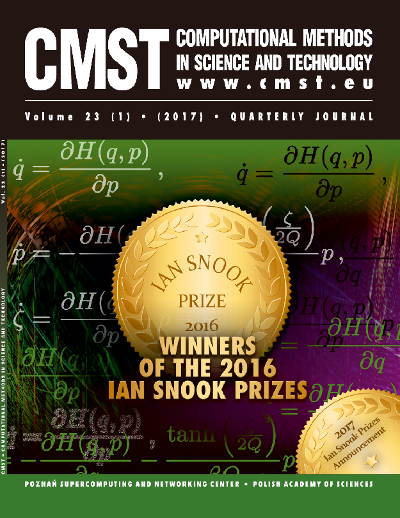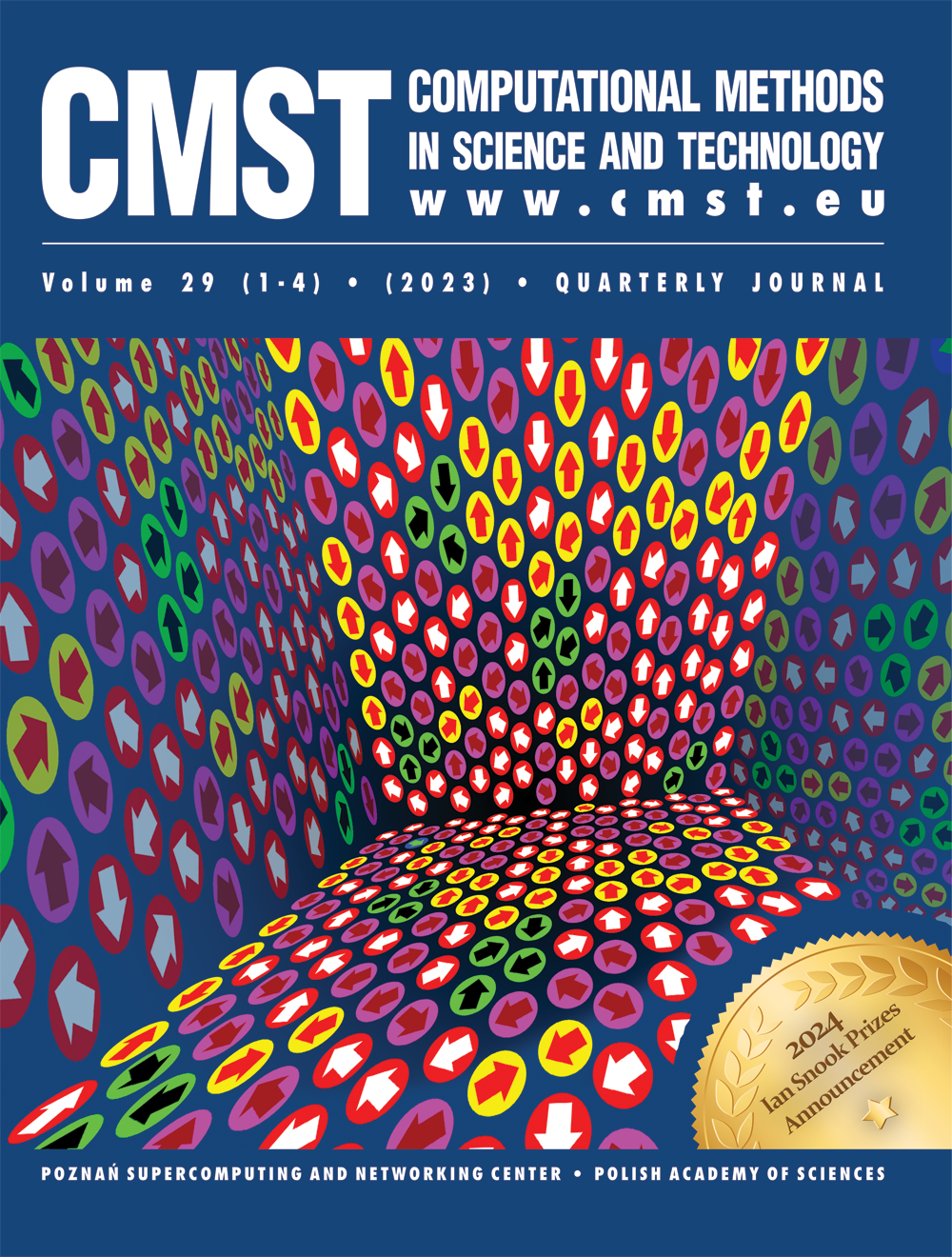METHODS OF COMPUTER SIMULATIONS OF PHASE TRANSITIONS IN THE ASHKIN-TELLER MODEL
Musiał Grzegorz 1, Dębski Lech 1, Kamieniarz Grzegorz 1, Rogiers J. 2
1 Institute of Physics, A. Mickiewicz University, ul. Umultowska 85, 61-614 Poznań, Poland
2Institute for Theoretical Physics, K. U. Leuven, Celestijnenlaan 200D, B-3001 Leuven, Belgium
DOI: 10.12921/cmst.2001.07.01.67-82
OAI: oai:lib.psnc.pl:516
Abstract:
The complementary Monte Carlo and series expansions methods of computer simulations have been described to investigate the critical behaviour of the Ashkin-Teller model in three dimensions. In the first method the invariance of the ratio of the square of the second moment of the order parameter to its fourth moment in the critical region has been exploited and some critical points on the phase boundaries have been calculated in the regions where the continuous transitions are expected. The continuity of the order parameter on the critical lines is verified by a finite size scaling analysis. Large-scale simulations have been performed on SGI Power Challenge XL and L supercomputers using the 64-bit random number generator.
The numerically generated series expansions method is described for which the effective algorithm for generation of graphs starting from polygons and based on collapsing the unlinked vertices, is introduced. The new feature of our algorithm is that for each graph we introduce new links between unlinked vertices and we decorate bonds with new vertices, so that more complex graphs in an early stage of the graph generation procedure are obtained. The resulting set of graphs enables the application of the series expansions method and achievement of the precision of allocation of points on the phase diagram comparable to the
precision of the Monte Carlo method, i.e. at least 3 decimal digits.
References:
[1] J. Ashkin, E. Teller, Phys. Rev., 64, 178 (1943).
[2] C. Fan, Phys. Lett., 39A, 136 (1972).
[3] P. Pawlicki, J. Rogiers, Physica, A214, 277 (1995).
[4] P. Pawlicki, G. Musiał, G. Kamieniarz, J. Rogiers, Physica, A242, 281 (1997).
[5] P. Pawlicki, G. Kamieniarz, L. Dębski, Physica, A242, 290 (1997).
[6] R. V. Ditzian, J. R. Banavar, G. S. Grest, L. P. Kadanoff, Phys. Rev., B22, 2542 (1980).
[7] P. Arnold, Y. Zhang, Nuclear Phys., B501, 803 (1997).
[8] G. Kamieniarz, H. W. J. Blöte, J. Phys. A: Math. Gen., 26, 201 (1993).
[9] H. W. J. Blote, E. Luijten, J. R. Herringa, J. Phys. A: Math. Gen., 28, 6289 (1995).
[10] A. L. Talapov, H. W. J. Blöte, J. Phys. A: Math. Gen., 29, 5727 (1996).
[11] B. G. Nickel, J. J. Rehr, J. Stat. Phys., 61, 1 (1990).
[12] C. Domb, Graph theory and embeddings, in: Phase Transitions and Critical Phenomena, ed. by C. Domb and M. S. Green, Academic, New York 1974, Vol. 3, p. 1.
[13] J. L. Martin, Computer techniques for evaluating lattice constants, ibidem, p. 97.
[14] B. R. Heap, J. Math. Phys., 7, 1582 (1966).
[15] G. Musiał, Comp. Meth. Sei. Techn., 4, 75 (1998).
[16] N. Metropolis, A. Rosenbluth, M. Rosenbluth, A. Teller, E. Teller, J. Chem. Phys., 21,1087 (1953).
[17] K. Binder and D. W. Heerman, Monte Carlo Simulation in Statistical Physics, Springer Series in Solid State Physics, Springer-Verlag, Berlin, Heidelberg 1988.
[18] J. Nagle, J. Math. Phys., 7, 1588 (1966).
[19] K. T. Balińska, J. Miądowicz, Graph Theory ofNew York, XXIX, 33 (1995);
http://www.man.poznan.pl/~balinska/
[20] K. T. Balińska, M. Kupczyk, private communication.
[21] E. A. Bender, E. R. Canfield, B. D. McKay, J. Combinat. Theory, A80, 124 (1997).
[22] R. J. Baxter, Exactly Solvable Models in Statistical Mechanics, Acad. Press, London 1982.
The complementary Monte Carlo and series expansions methods of computer simulations have been described to investigate the critical behaviour of the Ashkin-Teller model in three dimensions. In the first method the invariance of the ratio of the square of the second moment of the order parameter to its fourth moment in the critical region has been exploited and some critical points on the phase boundaries have been calculated in the regions where the continuous transitions are expected. The continuity of the order parameter on the critical lines is verified by a finite size scaling analysis. Large-scale simulations have been performed on SGI Power Challenge XL and L supercomputers using the 64-bit random number generator.
The numerically generated series expansions method is described for which the effective algorithm for generation of graphs starting from polygons and based on collapsing the unlinked vertices, is introduced. The new feature of our algorithm is that for each graph we introduce new links between unlinked vertices and we decorate bonds with new vertices, so that more complex graphs in an early stage of the graph generation procedure are obtained. The resulting set of graphs enables the application of the series expansions method and achievement of the precision of allocation of points on the phase diagram comparable to the
precision of the Monte Carlo method, i.e. at least 3 decimal digits.
[1] J. Ashkin, E. Teller, Phys. Rev., 64, 178 (1943).
[2] C. Fan, Phys. Lett., 39A, 136 (1972).
[3] P. Pawlicki, J. Rogiers, Physica, A214, 277 (1995).
[4] P. Pawlicki, G. Musiał, G. Kamieniarz, J. Rogiers, Physica, A242, 281 (1997).
[5] P. Pawlicki, G. Kamieniarz, L. Dębski, Physica, A242, 290 (1997).
[6] R. V. Ditzian, J. R. Banavar, G. S. Grest, L. P. Kadanoff, Phys. Rev., B22, 2542 (1980).
[7] P. Arnold, Y. Zhang, Nuclear Phys., B501, 803 (1997).
[8] G. Kamieniarz, H. W. J. Blöte, J. Phys. A: Math. Gen., 26, 201 (1993).
[9] H. W. J. Blote, E. Luijten, J. R. Herringa, J. Phys. A: Math. Gen., 28, 6289 (1995).
[10] A. L. Talapov, H. W. J. Blöte, J. Phys. A: Math. Gen., 29, 5727 (1996).
[11] B. G. Nickel, J. J. Rehr, J. Stat. Phys., 61, 1 (1990).
[12] C. Domb, Graph theory and embeddings, in: Phase Transitions and Critical Phenomena, ed. by C. Domb and M. S. Green, Academic, New York 1974, Vol. 3, p. 1.
[13] J. L. Martin, Computer techniques for evaluating lattice constants, ibidem, p. 97.
[14] B. R. Heap, J. Math. Phys., 7, 1582 (1966).
[15] G. Musiał, Comp. Meth. Sei. Techn., 4, 75 (1998).
[16] N. Metropolis, A. Rosenbluth, M. Rosenbluth, A. Teller, E. Teller, J. Chem. Phys., 21,1087 (1953).
[17] K. Binder and D. W. Heerman, Monte Carlo Simulation in Statistical Physics, Springer Series in Solid State Physics, Springer-Verlag, Berlin, Heidelberg 1988.
[18] J. Nagle, J. Math. Phys., 7, 1588 (1966).
[19] K. T. Balińska, J. Miądowicz, Graph Theory ofNew York, XXIX, 33 (1995);
http://www.man.poznan.pl/~balinska/
[20] K. T. Balińska, M. Kupczyk, private communication.
[21] E. A. Bender, E. R. Canfield, B. D. McKay, J. Combinat. Theory, A80, 124 (1997).
[22] R. J. Baxter, Exactly Solvable Models in Statistical Mechanics, Acad. Press, London 1982.



